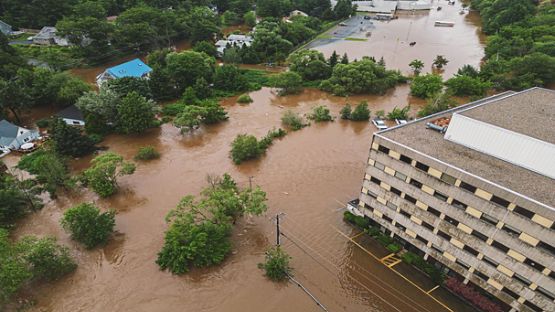A big part of risk management is analyzing and learning from historical events. What can our understanding of yesterday’s risks tell us about how to plan for tomorrow’s? What did we learn from actual events that will help us make more informed decisions?
In a presentation to the RIMS Canada conference, Shaun Walsh, Aviva Canada’s Vice President of Property and Reinsurance, offered some valuable insights designed to help professionals in the risk community learn from previous risks—and act proactively.
Plan for climate change-related risks
Significant weather events are nothing new in Canada. The West braces for wildfires every year. Hail season is part of every Alberta summer. Hurricanes and rainstorms are not unexpected in the East. But Walsh points to the sheer magnitude of events in 2024 alone as a harbinger for the intensity that should be expected in the future.
“The insured catastrophic losses across Canada in 2024 are close to $8.5 billion,” he said.1
“The increase in temperature and the pressure of land, air, and water is resulting in more frequent and intense weather events. Drier places are getting drier. Wet places are getting wetter. Previous areas that were not windy are now windy.”
With these increasingly significant events come learnings that businesses can use as they assess their property risks, the associated insurance coverages required, and the actions they can take to mitigate as much as possible.
Montreal rainstorm
Date: August 9, 2024
Scale: 200mm rain in 24 hours in 35 municipalities
Claims: 85,000
Industry losses: $2.5 billion2
Lesson learned: Flood hazard models work well, but prolonged periods of rain and saturated soil condition combined with inadequate storm sewer infrastructure that hasn’t kept up with urban sprawl and density have created increased risks in certain areas.
Risk response: With more localized, extreme rain events, there will be larger flood losses in areas that have not been historically affected.
Jasper wildfire
Date: July 22, 2024
Scale: 32,000 hectares burned; town of Jasper evacuated
Claims: 2,731
Industry losses: $890 million3
Lesson learned: Embers and smoke play a significant role in prolonging and growing wildfires.
Risk response: “Protecting the defensible area around a property is very important. It’s the difference between an ember that’s traveling 3km to start another fire or not,” said Walsh.
Expecting and responding to climate change is going to be a challenge that the insurance and risk management industries must address moving forward.
“We need to be better at understanding exposures to natural hazards. And then we need to understand the level of hazard that can impact us from a natural, catastrophic perspective, and not only based on today’s hazard level, but on future hazard levels that climate change is going to bring us in 2030, 2040, 2050, and beyond.”
Get ahead of greater global interdependency
As unique and independent each country likes to think it is, global events will always find their way in and create risk. And multiple events are increasingly colluding to create chain reactions.
“We saw with the pandemic that government lockdowns and geopolitical tensions very quickly affected supply chains and economies worldwide. We know now that one type of risk can become part of, even intensify, another,” said Walsh.
The lesson? “Know how your risk carriers will respond to a claim event and what their access to vendors are in the wake of a disaster. Do your legal diligence upfront. You can’t retrospectively write intent into policy coverage.”
Be prepared for increased cyber attacks
In Q3 of 2024 alone, there was a 75% surge in cyber attacks worldwide. This was not unexpected given our increasing reliance on technology and escalating cybersecurity concerns in the recent years.
Walsh says there are no two ways about it: appropriate cyber coverage is critical for all businesses.
“The lesson we have learned is that the weakest link in any cyber system is humans. While computer engineers continue to develop AI, let’s not forget that there is next to no meaningful governance. It’s critical to get the right cyber policy—the coverage that offers loss prevention advice (not AI generated) and offers incident response and can help you proactively prepare,” said Walsh.
Be aware of the rising costs of reinsurance
All property insurers in Canada rely directly or indirectly on the global reinsurance market for natural catastrophic (CAT) risk protection. With record CAT losses in the last few years, the price of reinsurance has trended upwards, and Walsh expects that to continue.
“That pricing is going up, so insurance companies’ net retentions are going up. That’s going to have consequential effects on insurers’ attitudes, where they offer catastrophic hazard protection and what they charge for it, and what [their deductible is] for it,” he said.
“Insurers have to increase their net exposure to CAT losses or look at alternative risk transfer mechanisms. If an insurer’s cost goes up, it will be passed onto policyholders or the insurer may be more selective about where it deploys its capital,” said Walsh.
Use resources available to help assess, plan for risk
When it comes to assessing and modelling a business’s risk, Walsh encouraged risk professionals to make use of the wealth of resources in the market.
“There’s an incredible amount of extremely insightful resources, especially technology innovations designed to make the current insurance model more efficient, that have been evolving over the past few years,” he said.
Other resources include:
- The Institute of Catastrophic Loss Reduction (ICLR)
- FireSmart Canada
- CatIQ
- RIMS Canada
- Insurance Bureau of Canada
“Brokers, intermediaries, and insurers such as Aviva are happy to help risk managers understand their hazard levels and make recommendations on mitigation and/or prevention,” said Walsh.
“We may use licensed tools and loss models for which we cannot share the output but we’re always happy to share an Aviva view of risk.”
Value property and communicate risks accurately
Walsh said almost half of large losses reveal an undervaluation of property and business interruption, especially in remoter parts of Canada.
“Defaulting to ‘unknown’ will not result in a good outcome. Our loss models, our data scientists, our actuarial pricing folks need accurate information. The better information we have, the better price you will get,” he said.
“We all need to work together on getting values correct to understand the risk.”
When considering coverages, Walsh has a few recommendations:
- “To build resilience, make sure your policy has a build back better extension.”
- “Make sure you have a provision in your business planning for a dollar or time deductible. If your dollar deductible is a percentage as it traditionally is for earthquake coverage in Canada, that percentage could be a big number.”
- “Get the right product for the right risk. Cyber coverage is a great example… get a cyber policy that offers good loss prevention advice and incident response.”
- “If you have tailored wording for your business, it’s a good idea to make sure the tailored clauses are legal proofed before a loss rather than trying to get a legal opinion after a loss.”
“We’re all learning. Work together. Share knowledge. Improve preparedness. Be ready as we can be for what is around the corner.”
Looking to protect your business against new and evolving risks?
Aviva’s Global Corporate & Specialty team offers a prevention-first approach that combines technological innovation with risk management. If your large corporate business requires protection, with expert claims management and dedicated support, our team can help.
2 Remnants of Hurricane Debby CAT IQ, ID: 08-2024-CAT-0193
3 Jasper Wildfire Complex CAT IQ ID: 2024-07-Cat-0191













